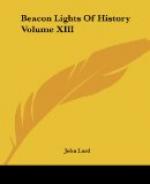Alfred Tennyson was born at his father’s rectory, Somersby, Lincolnshire, August 6,1809. He was the fourth of twelve children, seven of whom were sons, two of them, Frederick and Charles, being endowed, like Alfred, with poetic gifts. The poet’s mother, a woman of sweet and tender disposition, had much to do in moulding the future Laureate’s character; while from his father, a man of fine culture, he received not only much of his education, but his bent towards a recluse, bookish career. Alfred was from his earliest days a retired, shy child, fond of reading and given to rhyming, and with a characteristic love of nature and of quiet rural life. Later on he had a passion for the sea-coast, and for those scenes of storm and stress about the seagirt shores of old England which he was so feelingly and with such poetic beauty to depict in “Sea Dreams,” and in those incomparable songs, embodiments at once of sorrow and of faith, ‘Break, break, break,’ and ‘Crossing the Bar.’ Besides the education he received from his scholarly father, and at a school at Louth for four years, young Tennyson spent some years at Trinity College, Cambridge, where, though he did not take a degree, he won in 1829 the Chancellor’s medal for the best English poem of the year, the subject of which was ‘Timbuctoo.’ At college he had the good fortune to number among his friends several men who later in life were, like himself, to rise to eminence,—such as Henry Alford (afterwards Dean of Canterbury), R.C. Trench (later Archbishop of Dublin), C. Merivale (historian and Dean of Ely), Monckton Milnes (Lord Houghton), James Spedding (editor of Lord Bacon’s Works), Macaulay, Thackeray, and, most endeared of all, Arthur Henry Hallam, son of the historian, whose memory Tennyson has immortalized in “In Memoriam.” With him at college was also his brother Charles, one year his senior, with whom he collaborated in the collection of verse, issued in 1827, under the title of “Poems by Two Brothers.” In 1830, Tennyson made a journey to the Pyrenees with Arthur Hallam, who was engaged to the poet’s sister Emilia, and in the same year he published an independent volume, entitled “Poems chiefly Lyrical.” In this, his first venture alone in poetry, and in another issued in 1832, Tennyson was to manifest to the world his poetic powers and art, for they contained, besides much rhythmical and contemplative verse, such poems as ‘Mariana,’ ’Claribel; ‘Lilian,’ ‘Lady Clare,’ ‘The Lotus Eaters,’ ‘A Dream of Pair Women,’ ‘The May Queen,’ and ‘The Miller’s Daughter,’ In spite of the great promise bodied forth in these works, the volumes were subject to not a little unfavorable criticism, which stayed his further publishing for a period of ten years, though not the furtherance of his creative work, nor his enthusiastic efforts towards increasing the perfection of his art.




